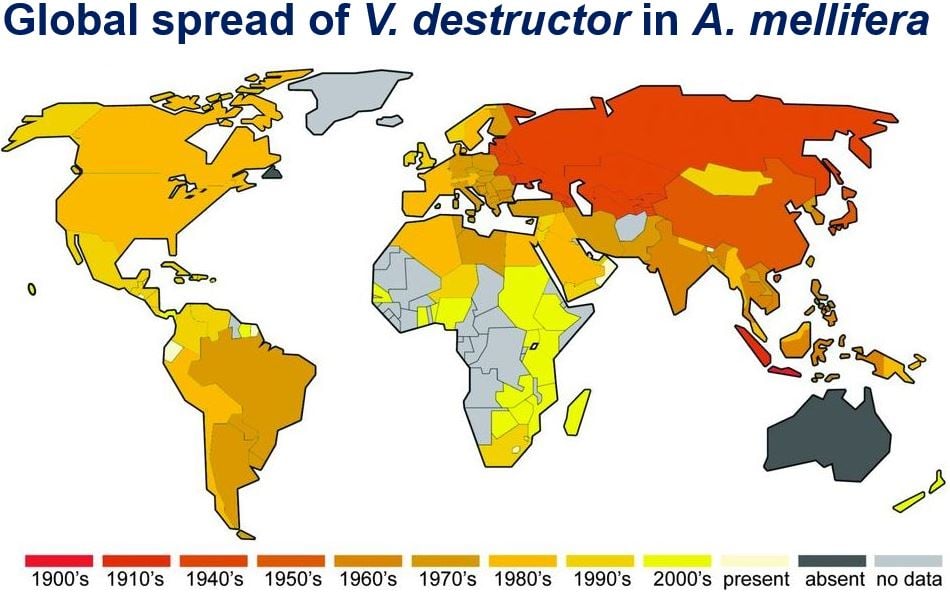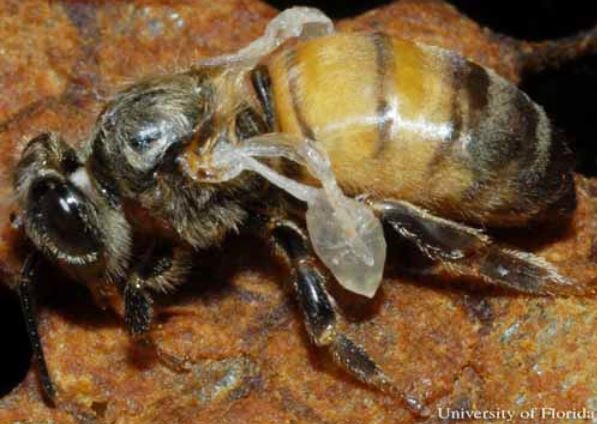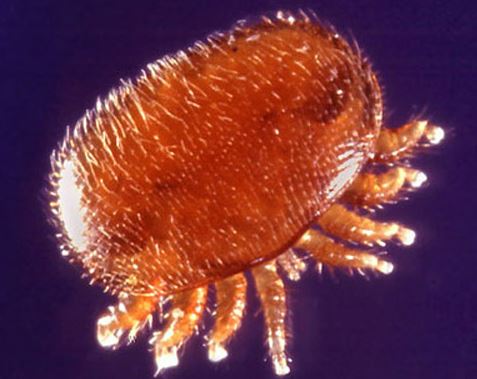The honeybee pandemic that has decimated bee populations globally is caused by human activity and driven by European honeybee population movements, says a team of scientists from United Kingdom, Switzerland and the United States.
Dr. Lena Wilfert, of the University of Exeter’s Centre for Ecology and Conservation, and colleagues wrote in the academic journal Science (citation below) that Apis mellifera – the European honeybee – is overwhelmingly the source of Deformed Wing Virus cases that have devastated hives worldwide.
The Deformed Wing Virus is one of 22 known viruses affecting honeybees. It induces wing deformity in the development of honeybee pupae, as well as other developmental deformities. Affected honeybees, which are typically expelled from the hive, have severely reduced life-spans – usually less than 48 hours.
 This world map shows the spread over time of V. destructor (varroa mite) in European Honeybees (A. mellifera), based on first records per country. Today, the only varroa-free large land masses with substantial honeybee populations are Newfoundland and Australia. Growing evidence suggests that sub-Saharan Africa has been invaded since the year 2000. (Image: science.sciencemag.org)
This world map shows the spread over time of V. destructor (varroa mite) in European Honeybees (A. mellifera), based on first records per country. Today, the only varroa-free large land masses with substantial honeybee populations are Newfoundland and Australia. Growing evidence suggests that sub-Saharan Africa has been invaded since the year 2000. (Image: science.sciencemag.org)
Honeybee transportation for crop pollination
According to a study carried out by scientists from the Universities of Exeter, Sheffield, Salford and Cambridge in England; the University of California Berkeley in the USA; and ETH Zürich (Swiss Federal Institute of Technology), the transportation of honeybees for crop pollination has been the main driver of the spread of disease.
While on their own, they are not serious threats to bee populations when the Varroa mite carries the disease, the combination is devastating, and has killed off several million honeybees over recent decades.
Varroa mites feed on honeybee larvae while the Deformed Wing Virus kills off bees – together, the double blow is devastating for colonies. The current honeybee colony decline is adding to concerns over the future of worldwide bee populations, with major implications for human health, global economies, agricultural biosecurity and biodiversity.
Europe source of global honeybee population decline
Dr. Wilfert said:
“This is the first study to conclude that Europe is the backbone of the global spread of the bee killing combination of Deformed Wing Virus and Varroa. This demonstrates that the spread of this combination is largely manmade – if the spread was naturally occurring, we would expect to see transmission between countries that are close to each other, but we found that, for example, the New Zealand virus population originated in Europe.”
“This significantly strengthens the theory that human transportation of bees is responsible for the spread of this devastating disease. We must now maintain strict limits on the movement of bees, whether they are known to carry Varroa or not. It’s also really important that beekeepers at all levels take steps to control Varroa in their hives, as this viral disease can also affect wild pollinators.”
 The European honeybee, also known as the Western honeybee (Apis mellifera) is commonly maintained by beekeepers for its honey product. Now that it has a fully-sequenced genome, it is an important organism for scientific studies. (Image: British Beekeepers Association)
The European honeybee, also known as the Western honeybee (Apis mellifera) is commonly maintained by beekeepers for its honey product. Now that it has a fully-sequenced genome, it is an important organism for scientific studies. (Image: British Beekeepers Association)
The scientists analysed sequence data of Deformed Wing Virus samples across the world from Varroa mites and honeybees, as well as the occurrence of Varroa.
Disease spread from Europe to Australasia and N. America
They used the data they had gathered and analysed to reconstruct the spread of Deformed Wing Virus, and found that the pandemic mainly spread from Europe to North America and Australasia.
They detected some two-way movement between Asia and Europe, but none between Australasia and Asia, despite their geographical proximity.
The team also examined samples of other species suspected of transmitting the disease, including different species of honeybee, bumblebees and mites, but concluded that the main transmitter was the European honeybee.
Co-author, Professor Roger Butlin, who works at Sheffield University’s Department of Animal and Plant Species, said:
“Our study has found that the deformed wing virus is a major threat to honeybee populations across the world and this epidemic has been driven by the trade and movement of honeybee colonies.”
“Domesticated honeybee colonies are hugely important for our agriculture systems, but this study shows the risks of moving animals and plants around the world. The consequences can be devastating, both for domestic animals and for wildlife. The risk of introducing viruses or other pathogens is just one of many potential dangers.”
 A honeybee infected with the deformed wing virus. (Image: University of Florida)
A honeybee infected with the deformed wing virus. (Image: University of Florida)
Senior author, Professor Mike Boots, of UC Berkeley and Exeter University, concluded:
“The key insight of our work is that the global virus pandemic in honeybees is manmade not natural. It’s therefore within our hands to mitigate this and future disease problems.”
In an Abstract in the journal, the authors wrote:
“DWV (deformed wing virus) exhibits epidemic growth and transmission that is predominantly mediated by European and North American honeybee populations and driven by trade and movement of honeybee colonies.”
 Dorsal view of adult varroa mite, Varroa destructor. (Image: University of Florida. Credit: Scott Bauer, USDA)
Dorsal view of adult varroa mite, Varroa destructor. (Image: University of Florida. Credit: Scott Bauer, USDA)
“DWV is now an important reemerging pathogen of honeybees, which are undergoing a worldwide manmade epidemic fueled by the direct transmission route that the Varroa mite provides.”
The study was funded by a Royal Society Dorothy Hodgkin Fellowship and the Natural Environment Research Council (NERC).
Human-honeybee relationship thousands of years old
An international team of scientists found that humans have been eating honey for at least 8,500 years, after detecting small traces of beeswax in Stone Age cooking vessels.
In this study, published in Nature last year, researchers from the UK, Slovenia, Finland, Germany, France, Austria, Serbia, Greece, Turkey, Algeria, Hungary, Portugal, Ireland, Italy, Tunisia, Poland and Spain gathered together evidence for the presence of beeswax in the cooking and eating utensils of Europe’s first farmers by analyzing the chemical components trapped in the clay fabric of more than 6,000 pieces of ceramic material (potsherds) from over 150 Old World archaeological sites.
They detected the chemical ‘fingerprint’ of beeswax in a large number of Neolithic sites across the European continent, thus showing how widespread the relationship between humans and honeybees was in prehistoric times.
The Neolithic Age (New Stone Age) dates from circa 10200 BC to between 4500 and 2000 BC.
Honeybee or Honey bee?
Most lay newspapers will use the one-word spelling – Honeybee, Housefly or Bedbug – while scientific journals tend to write them as two words – Honey Bee, House Fly and Bed Bug (I have seen some cases of one-word spelling in scientific journals).
The Oxford Dictionary and Merriam-Webster’s Dictionary write them as one word, while the ESA Common Names of Insects Database spells them as two words.
Which one is correct? They both are. If you are a writer/author, ask your editor-in-chief what the publisher prefers. If you are a student, ask your professor.
Citation: “Deformed wing virus is a recent global epidemic in honeybees driven by Varroa mites,” S. J. M. Martin, L. Wilfert, G. Long, R. Butlin, H. C. Leggett, P. Schmid-Hempe, M. Boots. Science. 5 February 2016. DOI: 10.1126/science.aac9976.
Video – US honeybee population plummets
The USDA reported that from April 2014 to April 2015 the number of thriving honeybee colonies in the USA declined by more than 40%, according to a survey involving approximately 6,000 beekeepers.
